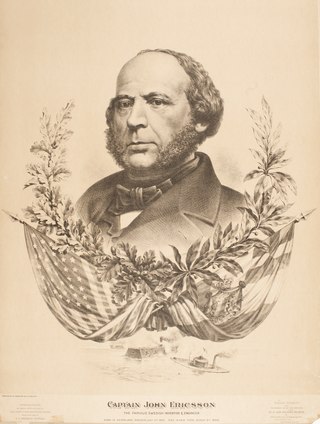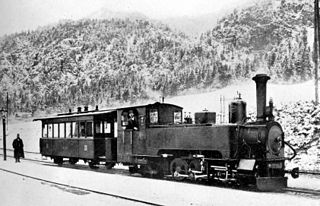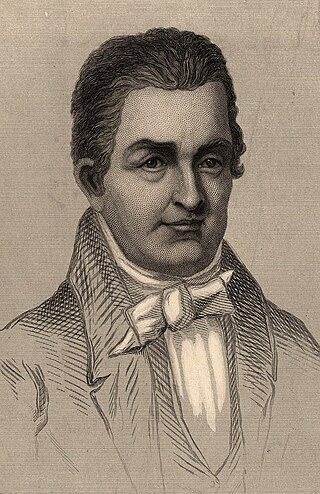Related Research Articles

John Ericsson was a Swedish-American inventor. He was active in England and the United States.
The White Motor Company was an American automobile, truck, bus and agricultural tractor manufacturer from 1900 until 1980. The company also produced bicycles, roller skates, automatic lathes, and sewing machines. Before World War II, the company was based in Cleveland, Ohio. White Diesel Engine Division in Springfield, Ohio, manufactured diesel engine generators, which powered U.S. military equipment and infrastructure, namely Army Nike and Air Force Bomarc launch complexes, and other guided missile installations and proving grounds, sections of SAGE and DEW Line stations, radars, Combat Direction Centers and other ground facilities of the U.S. aerospace defense ring, such as the Texas Towers.

A steamboat is a boat that is propelled primarily by steam power, typically driving propellers or paddlewheels. Steamboats sometimes use the prefix designation SS, S.S. or S/S or PS ; however, these designations are most often used for steamships.
Newburgh is a city in the U.S. state of New York, within Orange County. With a population of 28,856 as of the 2020 census, it is a principal city of the Poughkeepsie–Newburgh–Middletown metropolitan area. Located 60 miles (97 km) north of New York City, and 90 miles (140 km) south of Albany on the Hudson River within the Hudson Valley Area, the city of Newburgh is located near Stewart International Airport, one of the primary airports for Downstate New York.

Glenn Hammond Curtiss was an American aviation and motorcycling pioneer, and a founder of the U.S. aircraft industry. He began his career as a bicycle racer and builder before moving on to motorcycles. As early as 1904, he began to manufacture engines for airships. In 1908, Curtiss joined the Aerial Experiment Association, a pioneering research group, founded by Alexander Graham Bell at Beinn Bhreagh, Nova Scotia, to build flying machines.

The Second Industrial Revolution, also known as the Technological Revolution, was a phase of rapid scientific discovery, standardization, mass production and industrialization from the late 19th century into the early 20th century. The First Industrial Revolution, which ended in the middle of the 19th century, was punctuated by a slowdown in important inventions before the Second Industrial Revolution in 1870. Though a number of its events can be traced to earlier innovations in manufacturing, such as the establishment of a machine tool industry, the development of methods for manufacturing interchangeable parts, as well as the invention of the Bessemer process to produce steel, the Second Industrial Revolution is generally dated between 1870 and 1914.

The American Locomotive Company was an American manufacturer of locomotives, diesel generators, steel, and tanks that operated from 1901 to 1969. The company was formed by the merger of seven smaller locomotive manufacturers and Schenectady Locomotive Engine Manufactory of Schenectady, New York. A subsidiary, American Locomotive Automobile Company, designed and manufactured automobiles under the Alco brand from 1905 to 1913. ALCO also produced nuclear reactors from 1954 to 1962.

Oliver Evans was an American inventor, engineer and businessman born in rural Delaware and later rooted commercially in Philadelphia. He was one of the first Americans building steam engines and an advocate of high pressure steam. A pioneer in the fields of automation, materials handling and steam power, Evans was one of the most prolific and influential inventors in the early years of the United States. He left behind a long series of accomplishments, most notably designing and building the first fully automated industrial process, the first high-pressure steam engine, and the first amphibious vehicle and American automobile.

The Baldwin Locomotive Works (BLW) was an American manufacturer of railroad locomotives from 1825 to 1951. Originally located in Philadelphia, it moved to nearby Eddystone, Pennsylvania, in the early 20th century. The company was for decades the world's largest producer of steam locomotives, but struggled to compete as demand switched to diesel locomotives. Baldwin produced the last of its 70,000-plus locomotives in 1951, before merging with the Lima-Hamilton Corporation on September 11, 1951, to form the Baldwin-Lima-Hamilton Corporation.

Elisha Graves Otis was an American industrialist, founder of the Otis Elevator Company, and inventor of a safety device that prevents elevators from falling if the hoisting cable fails.

Early flying machines include all forms of aircraft studied or constructed before the development of the modern aeroplane by 1910. The story of modern flight begins more than a century before the first successful manned aeroplane, and the earliest aircraft thousands of years before.

The Grumman FF "Fifi" was an American biplane fighter aircraft operated by the United States Navy during the 1930s. It was the first carrier aircraft with retractable landing gear. It was produced under licence in Canada and known as the Goblin in Canadian service and Delfín in Spanish service.

The Lockheed J37 was one of the first turbojet engines designed in the United States. It was not considered very important when its development was first begun in the 1930s, and it was allowed to languish. By the time it was developed enough for production use, other engines, some British-derived, had surpassed it in performance. The design was later converted to a turboprop, the T35 and still later sold to Wright Aeronautical, where it saw some interest for use on what would become the B-52 Stratofortress, before that design moved to jet power. The J37 and T35 were built to the extent of a number of testbed examples but never entered production.

Charles Tillinghast James was a consulting manufacturing engineer, early proponent of steam mills, and United States Democratic Senator from the state of Rhode Island from 1851 to 1857.

The Doble steam car was an American steam car maker from 1909 to 1931. Its latter models of steam car, with fast-firing boiler and electric start, were considered the pinnacle of steam car development. The term "Doble steam car" comprises any of several makes of steam-powered automobile in the early 20th century, including Doble Detroit, Doble Steam Car, and Doble Automobile, severally called a "Doble" because of their founding by Abner Doble.

John Penn (1805–1878) was an English marine engineer whose firm was pre-eminent in the middle of the 19th century due to his innovations in engine and propeller systems, which led his firm to be the major supplier to the Royal Navy as it made the transition from sail to steam power. He was also president of the Institution of Mechanical Engineers on two occasions.

A marine steam engine is a steam engine that is used to power a ship or boat. This article deals mainly with marine steam engines of the reciprocating type, which were in use from the inception of the steamboat in the early 19th century to their last years of large-scale manufacture during World War II. Reciprocating steam engines were progressively replaced in marine applications during the 20th century by steam turbines and marine diesel engines.
John Penn and Sons was an English engineering company based in London, and mainly known for its marine steam engines.

George Washington Rains was a United States Army and later Confederate States Army officer. A skilled engineer and inventor; he was instrumental in providing the Confederacy with much-needed gunpowder throughout the American Civil War. He also was the younger brother of fellow Confederate general Gabriel J. Rains.
Agnes E. Fry was a US Confederate blockade runner built by the shipyard of Caird & Company in Greenock on the lower River Clyde in Scotland, and launched on 26 March 1864 under the name of "Fox". The paddle steamer had an iron hull, and was powered by two oscillating cylinder steam engines. The ship was under the command of Joseph Fry, who renamed it after his wife when he took command. She was scuttled near the mouth of the Cape Fear River, Oak Island, North Carolina sometime around January 1865. The ship's wreckage may have been found by sonar on 27 February 2016.
References
- ↑ Jay Leno (1 October 2009). "Jay Leno Goes Green with Time-Tested Steam". Popular Mechanics. Retrieved 15 January 2013.
- ↑ Vintage Machinery: Wright Steam Engine Works, Newburg, NY, U.S.A.
- ↑ US Patent: 43,362 Oscillating Steam Engine
- ↑ Civil War Navies, 1855-1883, US Hibiscus
- ↑ Thomas S. Wermuth; James Michael Johnson; Christopher Pryslopski (2009). America's First River: The History and Culture of the Hudson River Valley. SUNY Press. p. 123. ISBN 978-0-615-30829-6 . Retrieved 19 January 2013.
- ↑ Kevin Barrett (1999). Newburgh. Arcadia Publishing. p. 27. ISBN 978-0-7385-0338-7 . Retrieved 19 January 2013.